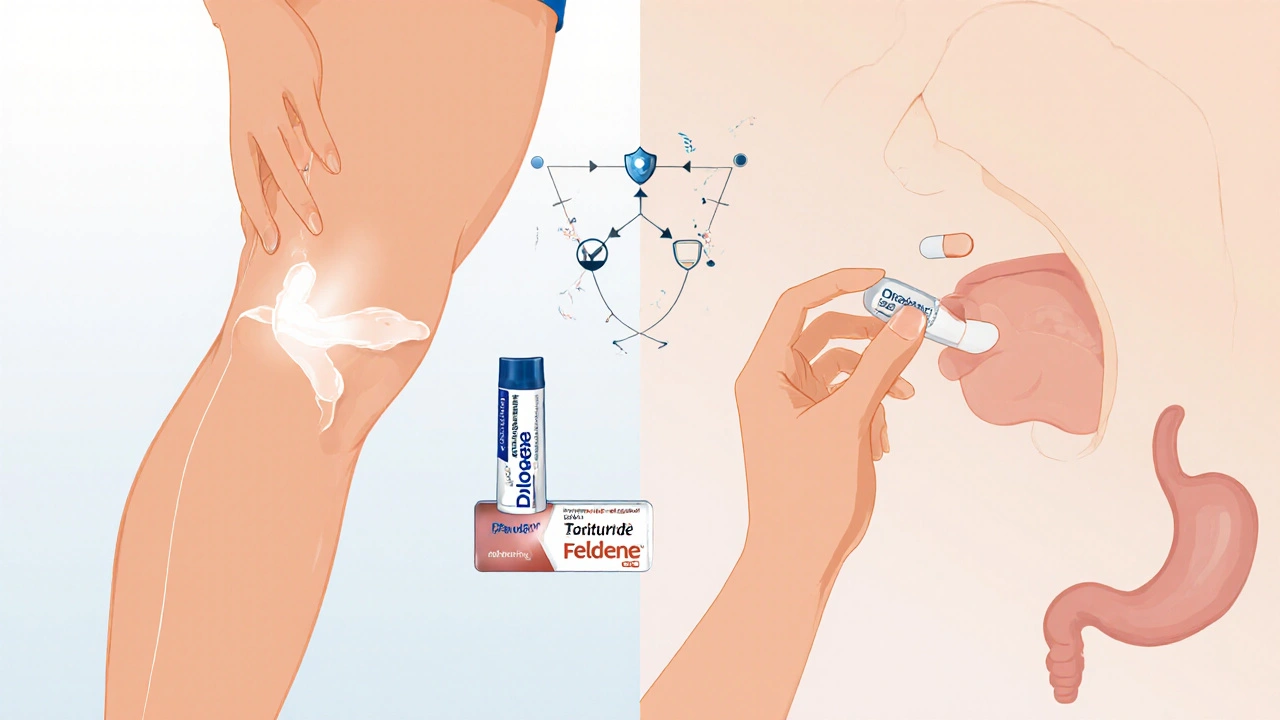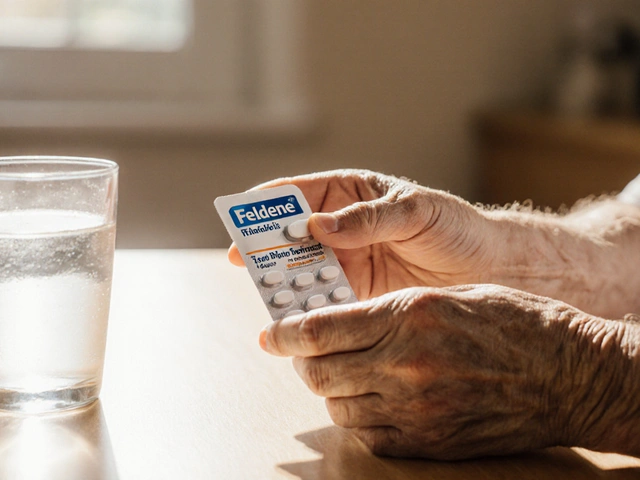NSAID Selection Guide
Select your condition, health considerations, and preferences to find your best NSAID option. This tool is not a substitute for medical advice.
Step 1: What is your main condition?
Step 2: What health considerations do you have?
Step 3: What are your preferences?
Recommended NSAID
Key Takeaways
- Feldene (Piroxicam) is a potent NSAID with a long half‑life, good for chronic inflammatory conditions but carries higher GI risk.
- Celecoxib offers cardio‑friendly COX‑2 selectivity but is pricier and less effective for severe pain.
- Ibuprofen and naproxen are inexpensive, fast‑acting, and suitable for short‑term use, though they can irritate the stomach.
- Diclofenac and meloxicam sit between potency and safety, often chosen for musculoskeletal pain.
- Topical NSAIDs provide local relief with minimal systemic exposure, ideal for patients who can’t tolerate oral drugs.
When doctors prescribe Feldene (Piroxicam) is a non‑steroidal anti‑inflammatory drug (NSAID) used to relieve pain and inflammation. It’s been on the market since the 1970s and still shows up in prescriptions for arthritis, gout and postoperative pain. But the drug isn’t a one‑size‑fits‑all. Below we compare Feldene with other popular NSAIDs, looking at how they work, how fast they act, dosing quirks, and the safety trade‑offs that matter to everyday patients.
What Is Feldene (Piroxicam)?
Piroxicam is the generic name for the brand Feldene. It belongs to the oxicam class of NSAIDs, which block the cyclooxygenase (COX) enzymes that produce prostaglandins - the chemicals that cause pain, fever and swelling.
Key attributes:
- Half‑life: 40-50hours (allows once‑daily dosing).
- Onset of relief: 1-2hours.
- Usual oral dose: 10-20mg once daily.
- Metabolism: Hepatic, with renal excretion.
How Feldene Works
The oxicam structure gives piroxicam a stronger affinity for both COX‑1 and COX‑2 enzymes, meaning it reduces inflammation effectively. However, COX‑1 inhibition also means it can damage the stomach lining, leading to ulcers or bleeding, especially in older adults or those on steroids.
When to Choose Feldene
Feldene shines in chronic conditions where steady drug levels are beneficial - rheumatoid arthritis, osteoarthritis, and chronic low back pain. Its long half‑life reduces the need for multiple daily pills, which helps adherence. But because of the GI risk, clinicians often pair it with a proton‑pump inhibitor (PPI) or prescribe it only when other NSAIDs aren’t tolerated.
Overview of Common NSAID Alternatives
Below are the main contenders you’ll see on a typical prescription list.
Celecoxib is a COX‑2‑selective NSAID that aims to spare the stomach while still delivering strong anti‑inflammatory action.
Ibuprofen is the classic over‑the‑counter NSAID, fast‑acting and inexpensive, best for mild‑to‑moderate pain.
Naproxen offers a longer duration than ibuprofen, making it popular for musculoskeletal aches.
Diclofenac is a potent NSAID often prescribed for acute flare‑ups of arthritis or postoperative pain.
Meloxicam sits between ibuprofen and diclofenac in strength, with once‑daily dosing for osteoarthritis.
Etoricoxib is another COX‑2‑selective drug, used mainly in Europe and Canada for chronic pain.
Diclofenac Gel (topical) delivers the drug directly to the joint or tendon, reducing systemic exposure.
Side‑by‑Side Comparison
| Drug | Class / Selectivity | Typical Dose | Onset (hrs) | GI Risk | Cardio Risk | Common Indications |
|---|---|---|---|---|---|---|
| Piroxicam (Feldene) | Oxicam - non‑selective COX | 10-20mg daily | 1-2 | High | Moderate | Rheumatoid arthritis, osteoarthritis, gout |
| Celecoxib | COX‑2 selective | 100-200mg daily | 1-2 | Low | Higher (especially with >200mg) | Arthritis, acute pain, menstrual cramps |
| Ibuprofen | Propionic acid - non‑selective COX | 200-400mg q6‑8h | 0.5-1 | Moderate | Low‑moderate | Headache, dental pain, minor sprains |
| Naproxen | Propionic acid - non‑selective COX | 250-500mg bid | 1-2 | Moderate | Low | Muscle pain, menstrual cramps, arthritis |
| Diclofenac | Acetic acid - non‑selective COX | 50-75mg t.i.d. | 0.5-1 | High | Moderate‑high | Post‑operative pain, gout, ankylosing spondylitis |
| Meloxicam | Enolic acid - slightly COX‑2 preferring | 7.5-15mg daily | 1-2 | Moderate | Low‑moderate | Osteoarthritis, rheumatoid arthritis |
| Etoricoxib | COX‑2 selective | 30-120mg daily | 1-2 | Low | Higher at >60mg | Chronic back pain, OA, gout |
| Diclofenac Gel | Topical NSAID | Apply 2-4g to affected area 3‑4times daily | 0.5-1 (local) | Very low (systemic) | Very low | Localized joint pain, tendonitis |
Pros and Cons of Each Option
Feldene (Piroxicam) provides steady pain control with once‑daily dosing, which is great for adherence. The downside is a higher chance of stomach irritation and a need for monitoring in patients with kidney disease.
Celecoxib reduces stomach problems but can raise blood pressure and clotting risk, especially at higher doses. It’s pricey, yet many insurance plans cover it for arthritis.
Ibuprofen is inexpensive and works fast, making it perfect for acute aches. Its short half‑life means you might need 3‑4 doses a day, and prolonged use still hurts the gut.
Naproxen lasts longer than ibuprofen, so twice‑daily dosing often suffices. It’s considered the safest NSAID for heart‑disease patients, but the GI risk remains moderate.
Diclofenac is very effective for severe flare‑ups, yet it carries the highest cardiovascular warning among oral NSAIDs. Use it only when benefits outweigh risks.
Meloxicam offers once‑daily dosing with a slightly better GI profile than non‑selective NSAIDs, but it still isn’t as gentle as COX‑2 blockers.
Etoricoxib gives strong inflammation control with low GI upset, but its cardiovascular safety limit means doctors stay cautious, especially in older patients.
Diclofenac Gel shines for localized knee or elbow pain without the systemic side effects of pills. The trade‑off is that deep joint pain may not get enough drug through the skin.

Choosing the Right NSAID for Your Situation
Think of the decision as matching three variables: the severity of pain, your personal health profile, and how you like to take medication.
- Mild, occasional pain (headache, minor sprain): Ibuprofen or naproxen on an as‑needed basis works well.
- Chronic joint pain with good stomach health: Meloxicam or piroxicam (Feldeni) can be used once daily for convenience.
- History of ulcers or on aspirin therapy: Switch to a COX‑2‑selective drug like celecoxib or etoricoxib, and add a PPI.
- Cardiovascular disease risk: Naproxen or low‑dose ibuprofen are generally safer; avoid diclofenac and high‑dose celecoxib.
- Need for local relief without systemic exposure: Diclofenac gel or other topical NSAIDs are the answer.
Always discuss kidney function, liver enzymes, and any other meds (e.g., anticoagulants) with your clinician before starting an NSAID.
Safety Tips & Common Interactions
- Take with food: Most oral NSAIDs, especially piroxicam, should be taken with meals to blunt stomach irritation.
- Avoid alcohol: Combining alcohol with any NSAID raises bleeding risk.
- Watch blood pressure: COX‑2 inhibitors can cause fluid retention and raise BP; monitor regularly.
- Check kidney function: NSAIDs reduce renal blood flow; patients with chronic kidney disease need dose adjustments or alternatives.
- Drug‑drug clashes: Anticoagulants (warfarin, DOACs), SSRIs, and lithium all interact with NSAIDs, increasing bleed or toxicity risk.
Bottom Line
Feldene remains a solid choice for patients who need consistent, once‑daily control of chronic inflammation and can tolerate the gastrointestinal side‑effects or are protected with a PPI. For those worried about stomach or heart health, the COX‑2‑selective options or topical NSAIDs provide a gentler route, albeit often at a higher cost.
Frequently Asked Questions
Can I take Feldene with a proton‑pump inhibitor?
Yes. Combining piroxicam with a PPI such as omeprazole or esomeprazole significantly lowers the risk of stomach ulcers, especially in patients over 60 or those with a history of GI bleeding.
How does Feldene compare to ibuprofen for osteoarthritis?
Ibuprofen works faster but usually requires three or four doses a day. Feldene offers a smoother, 24‑hour coverage with a single tablet, making it preferable for patients who struggle with multiple daily pills. However, ibuprofen carries a lower gastrointestinal risk for short‑term use.
Is it safe to use Feldene while on blood thinners?
Mixing piroxicam with anticoagulants (warfarin, apixaban, etc.) increases bleeding risk. If both are needed, the doctor will likely opt for a lower‑risk NSAID like naproxen and will monitor clotting parameters closely.
What are the signs of a serious stomach ulcer from Feldene?
Watch for dark or tarry stools, vomiting blood (or coffee‑ground material), sudden abdominal pain, or unexplained weakness. Any of these symptoms require immediate medical attention.
Are topical NSAIDs as effective as oral ones for knee pain?
For mild‑to‑moderate knee osteoarthritis, diclofenac gel can provide comparable pain relief with far fewer systemic side effects. Severe inflammation may still need an oral NSAID for full effect.

